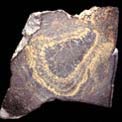Hydrothermal vents
By Richard Herrington

Section through a black smoker chimney
Hydrothermal vents have characterised parts of the seafloor since oceans first formed, and modern vents are sites of thriving faunal communities developed around chemical energy sources in the total absence of light.
Richard Herrington, of the department of mineralogy at The Natural History Museum, London, examines vents sites and their associated animal life through geological time, aided by discoveries illuminated by modern seafloor exploration techniques, developed less than 30 years ago. These have enabled scientists to speculate about the contribution of vents to the very origins of life, both on Earth and possibly on other planets.
Hydrothermal vents PDF (233.5 KB)

The Museum's smallest members of staff are our flesh-eating beetles, Dermestes maculates, who strip carcasses to the bone.